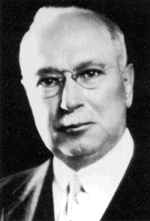
Miner
Noah A. Timmins
1867 — 1936
Noah Anthony Timmins (March 31, 1867 – January 22, 1936) was a Canadian mining financier and developer who is now counted among the founding fathers of Canada's mining industry.
Noah Timmins partnered with his older brother Henry in 1903 to buy into the La Rose silver claim in Cobalt, Ontario at the onset of the Cobalt silver rush. Fred La Rose, a blacksmith, while working for brothers Duncan and John McMartin in the construction of the Temiskaming and Northern Ontario Railway (T&NO) at Mile 103 from North Bay, Ontario, where he had built a small cabin, there chanced upon Erythrite, often an indication of associated cobalt and native silver. (A fanciful story later developed that La Rose discovered the vein when he threw a hammer at a pesky fox.)
Noah subsequently heard of the claim from La Rose, who, at the end of his contract, had stopped at the Timmins brothers' general store in Mattawa, while returning to his home in Hull, Quebec. Noah cabled Henry, who was in Montreal, and immediately set out for Hull, where he met with La Rose and offered him $3,500 for a quarter share of the claim, effectively partnering with the McMartin brothers.
The foursome soon added a friend of the Timmins brothers, attorney David Alexander Dunlapes (1863-1924), for whom the David Dunlap Observatory was named, as a full fifth partner after he had successfully defended their claim in a "nasty dispute" with then former Temiskaming and Northern Ontario Railway Commissioner M. J. O'Brien.5]
In 1910, the five partners incorporated as the Canadian Mining and Finance Company, Limited (later Hollinger Mines), with Noah appointed President.6]7] In 1916, officers of the corporation were reported as: "President, L. H. Timmins, Montreal; vice-president, J. McMartin, Cornwall, Ont.; treasurer, D. A. Dunlap, Toronto; secretary, John B. Holden, Toronto; general manager, P. A. Bobbins, Timmins, Ont."8]
Noah and his nephew, Alphonse "Al" Paré, then a student mining engineer at the Royal Military College of Canada, had negotiated with Alex Gillies (for whom Gillies Lake is named), and Benny Hollinger, who had uncovered what became known as the Hollinger Gold Mine. Paré described the find: "It was as if a giant cauldron had splattered the gold nuggets over a bed of pure blue quartz crystals as a setting for some magnificent crown jewels of inestimable value." On the strength of his nephew's information, Noah committed himself to paying $530,000. Noah put Paré, who had assessed the Hollinger Mine's potential, in charge of its operation for two years after incorporation. Hollinger Mines became known as one of the "Big Three" Canadian mines, together with the Dome Mine and the McIntyre Mines.
Although the family company explored stakes and mining operations all over the world, their greatest development remained the important Hollinger Mine in Timmins, Ontario, originally founded as a company town to house miners, which Paré had named after his uncle, Noah, in 1912.
Last Updated on: 2024-02-28
